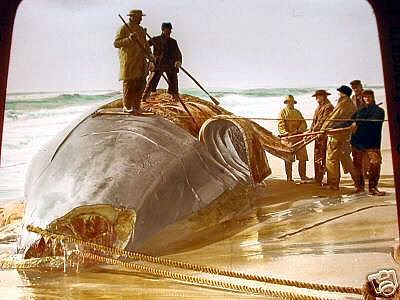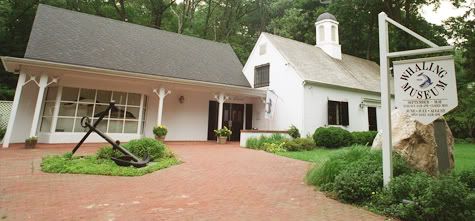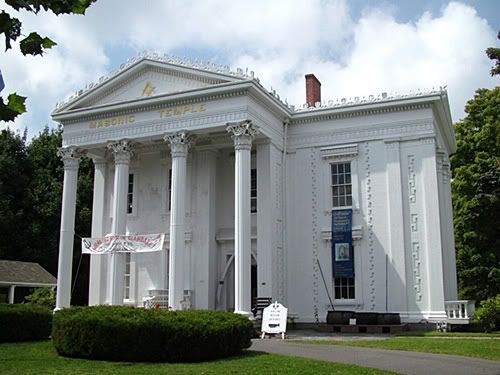
Native Americans on Long Island were the islands first whalers. They often used whales that washed up on the shoreline for the oil, bone and flesh. The whale oil was an important resource to Europeans who early on hired the Native Americans to hunt whales in return for goods. Eventually this business came to be dominated by the whites who resented the high prices paid to the Native Americans.
Whaling had been popular in the Massachusetts Bay Colony and when settlers from Massachusetts moved to Long Island in the 1640's they made whaling a regular business. Many whaling companies were formed on the Island such as the East Hampton Company and South Hampton Company.
The first step in whaling was to have a lookout where whales could be seen. The person at the lookout would yell, "Whale off" or "There she blows", when a whale was spotted. It was then time to board the boats in 6 man crews and go after the whales.
It was a long and hard struggle by the crew to catch a whale. After a whale was caught they were hauled up on shore and the bone and blubber (the fat of the whale) were cut out. The blubber was then "tried out" which means boiled down to oil in big iron trypots. The boiling caused such a stink, the town of Southampton had to pass a law limiting the amount of oil that could be boiled. However, the stink caused by the boiling didn't bother the whalers. The oil produced by this method could then be sold by the whalers for large amounts of money. People purchased whale oil for use in lamps and candles. Whale oil was so important to Long Islanders that it was used to pay their debts and taxes. To the children of Long Island, whale oil had a special meaning. Many schools on Long Island would be closed during whaling season, from December until April.
Some whale hunts would take a long time. On these hunts the whalers had a great deal of time to pass. One way they did this was by an art known as scrimshaw. Scrimshaw was an art in which whalers carved pictures on to whale teeth. The teeth of these whales were made of ivory and beautiful works of art could be made from them. The whalers greatly enjoyed this pastime and could also make a small profit by selling their artwork.
Whaling continued to grow during the 1700's. By the 1800's large ships containing huge crews and advanced weapons were being used to hunt whales. Two of the great whaling towns of the time were Cold Spring Harbor and Sag Harbor. So great was the amount of whaling taking place in Sag Harbor, that George Washington declared it a port of entry in 1797. The Custom House (a place where they collect taxes) there still stands. Over 500 whale voyages were made from Sag Harbor between 1790 and 1870 and great profits were made. However, in the early 1850's the whaling industry began to decline due to increased industrialization.
Fishing was also a large industry on the north and south forks of Long Island's East End. For centuries Long Island baymen (fishermen) earned their living harvesting shellfish. Some of the big fishing towns were Montauk, Sag Harbor, and the Hamptons. In recent times there has been a major decline in commercial (for profit) fishing. Pollution, greed, inadequate regulation, poor management, and natural factors have combined to reduce the clam harvest by seventy percent since 1976. The one hundred million dollar industry of the 1970's has shrunk to less than forty million dollars. Thousands of baymen whose families have worked Long Island waters for generations have been forced to leave. The problems of these people was captured by Long Island's Billy Joel in his song the "Downeaster Alexa."
Another factor which is contributing to the decline of the fishing industry is that sport fishing has become more popular. Baymen have developed ill feelings towards the sport fishermen because of the striped bass, which is a fish that both parties hunt and need.
Overall, commercial fishing is not as profitable, popular, or widespread as it used to be. As a result, Long Island is not the center of whaling and fishing like it was in the early 1800's. Still many Long Islanders enjoy fishing and rely on the seas for their source of living and the waters around Long Island, particularly the Long Island Sound, have actually gotten cleaner is recent years. This is a good sign and means that more fish are able to live off our shores.

Cold Spring Harbor Whaling Museum
www.cshwhalingmuseum.org

Sag Harbor Whaling Museum
www.sagharborwhalingmuseum.org
1 comment:
cant fucken believe that there is such thing as a whaling museum....
Post a Comment